2011 Hyundai Accent wheel
[x] Cancel search: wheelPage 11 of 232
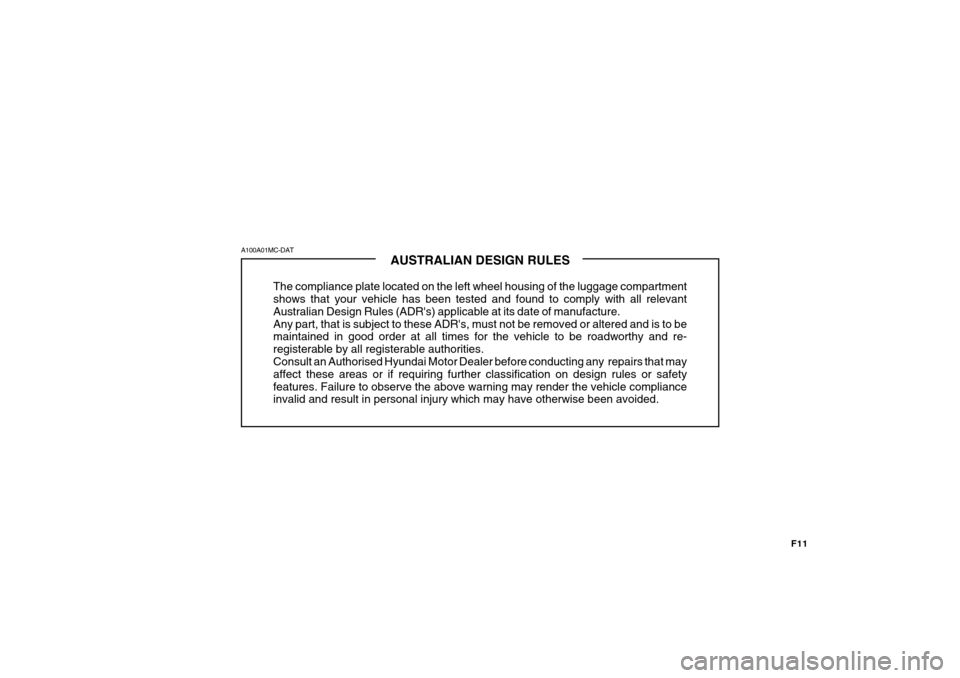
F11
AUSTRALIAN DESIGN RULES
The compliance plate located on the left wheel housing of the luggage compartment shows that your vehicle has been tested and found to comply with all relevant Australian Design Rules (ADR's) applicable at its date of manufacture.Any part, that is subject to these ADR's, must not be removed or altered and is to be maintained in good order at all times for the vehicle to be roadworthy and re- registerable by all registerable authorities. Consult an Authorised Hyundai Motor Dealer before conducting any repairs that may affect these areas or if requiring further classification on design rules or safetyfeatures. Failure to observe the above warning may render the vehicle compliance invalid and result in personal injury which may have otherwise been avoided.
A100A01MC-DAT
Page 49 of 232
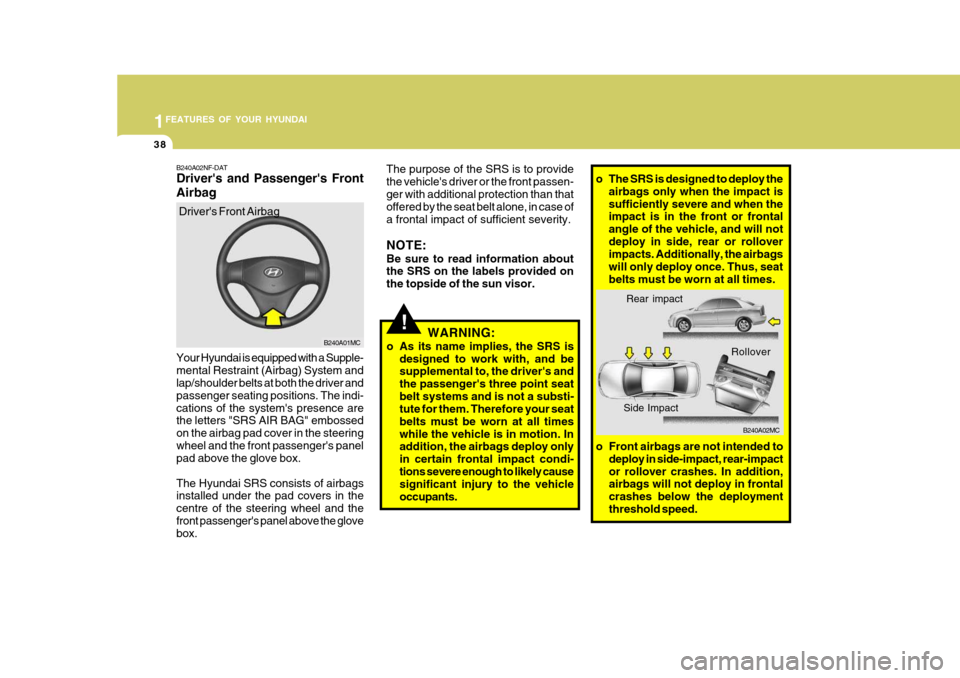
1FEATURES OF YOUR HYUNDAI
38
!
B240A01MC
o Front airbags are not intended todeploy in side-impact, rear-impact or rollover crashes. In addition, airbags will not deploy in frontal crashes below the deploymentthreshold speed.
o The SRS is designed to deploy the
airbags only when the impact issufficiently severe and when the impact is in the front or frontal angle of the vehicle, and will notdeploy in side, rear or rollover impacts. Additionally, the airbags will only deploy once. Thus, seatbelts must be worn at all times.
WARNING:
o As its name implies, the SRS is designed to work with, and be supplemental to, the driver's and the passenger's three point seatbelt systems and is not a substi- tute for them. Therefore your seat belts must be worn at all timeswhile the vehicle is in motion. In addition, the airbags deploy only in certain frontal impact condi-tions severe enough to likely cause significant injury to the vehicle occupants.
Your Hyundai is equipped with a Supple-mental Restraint (Airbag) System and lap/shoulder belts at both the driver and passenger seating positions. The indi-cations of the system's presence are the letters "SRS AIR BAG" embossed on the airbag pad cover in the steeringwheel and the front passenger's panel pad above the glove box. The Hyundai SRS consists of airbags installed under the pad covers in the centre of the steering wheel and thefront passenger's panel above the glove box.
B240A02NF-DAT Driver's and Passenger's Front Airbag
Driver's Front Airbag The purpose of the SRS is to provide the vehicle's driver or the front passen-ger with additional protection than that offered by the seat belt alone, in case of a frontal impact of sufficient severity. NOTE: Be sure to read information about the SRS on the labels provided on the topside of the sun visor.
B240A02MC
Rear impact
Side Impact Rollover
Page 50 of 232
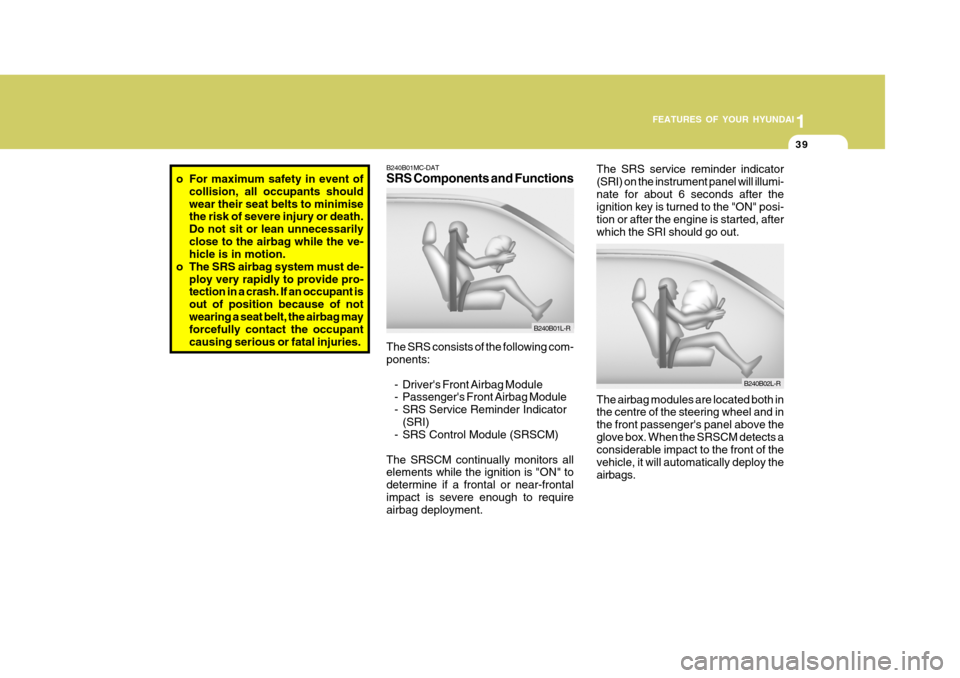
1
FEATURES OF YOUR HYUNDAI
39
o For maximum safety in event of
collision, all occupants should wear their seat belts to minimise the risk of severe injury or death. Do not sit or lean unnecessarilyclose to the airbag while the ve- hicle is in motion.
o The SRS airbag system must de- ploy very rapidly to provide pro-tection in a crash. If an occupant is out of position because of notwearing a seat belt, the airbag may forcefully contact the occupant causing serious or fatal injuries. The SRS consists of the following com- ponents:
- Driver's Front Airbag Module
- Passenger's Front Airbag Module
- SRS Service Reminder Indicator(SRI)
- SRS Control Module (SRSCM)
The SRSCM continually monitors all elements while the ignition is "ON" to determine if a frontal or near-frontalimpact is severe enough to require airbag deployment.
B240B01MC-DAT SRS Components and Functions
The SRS service reminder indicator (SRI) on the instrument panel will illumi-nate for about 6 seconds after the ignition key is turned to the "ON" posi- tion or after the engine is started, afterwhich the SRI should go out.
B240B01L-R
B240B02L-R
The airbag modules are located both in the centre of the steering wheel and in the front passenger's panel above theglove box. When the SRSCM detects a considerable impact to the front of the vehicle, it will automatically deploy theairbags.
Page 53 of 232
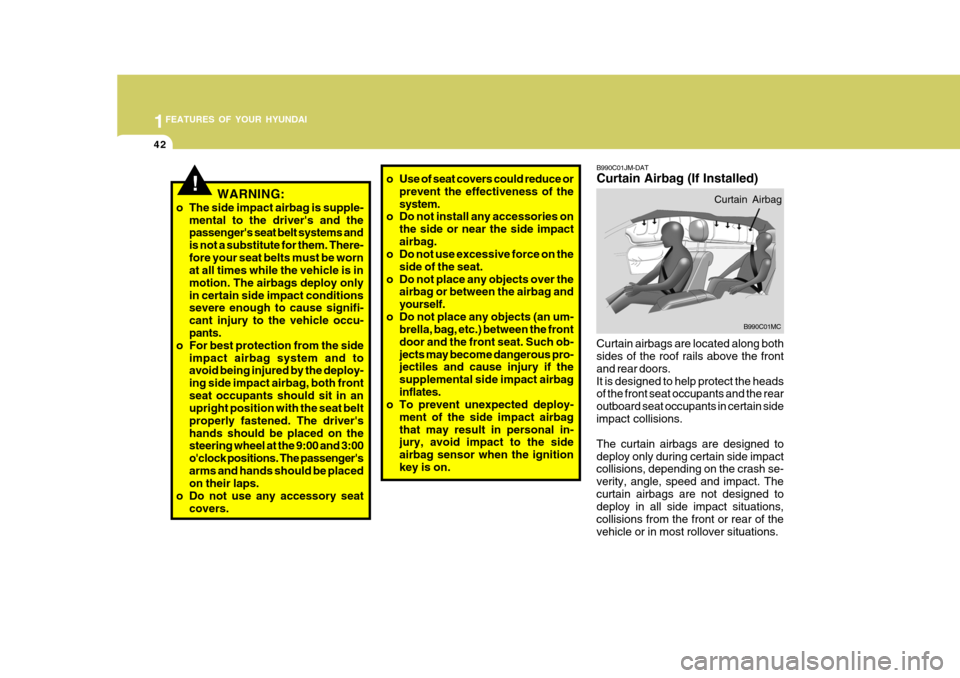
1FEATURES OF YOUR HYUNDAI
42
!o Use of seat covers could reduce or
prevent the effectiveness of the system.
o Do not install any accessories on
the side or near the side impactairbag.
o Do not use excessive force on the
side of the seat.
o Do not place any objects over the airbag or between the airbag andyourself.
o Do not place any objects (an um- brella, bag, etc.) between the frontdoor and the front seat. Such ob-jects may become dangerous pro- jectiles and cause injury if the supplemental side impact airbaginflates.
o To prevent unexpected deploy-
ment of the side impact airbagthat may result in personal in- jury, avoid impact to the side airbag sensor when the ignitionkey is on.
WARNING:
o The side impact airbag is supple- mental to the driver's and the passenger's seat belt systems and is not a substitute for them. There-fore your seat belts must be worn at all times while the vehicle is in motion. The airbags deploy onlyin certain side impact conditions severe enough to cause signifi- cant injury to the vehicle occu-pants.
o For best protection from the side
impact airbag system and to avoid being injured by the deploy- ing side impact airbag, both frontseat occupants should sit in an upright position with the seat belt properly fastened. The driver'shands should be placed on the steering wheel at the 9:00 and 3:00 o'clock positions. The passenger'sarms and hands should be placed on their laps.
o Do not use any accessory seat covers.
B990C01JM-DAT Curtain Airbag (If Installed)
Curtain airbags are located along both sides of the roof rails above the front and rear doors.It is designed to help protect the heads of the front seat occupants and the rear outboard seat occupants in certain sideimpact collisions. The curtain airbags are designed to deploy only during certain side impact collisions, depending on the crash se- verity, angle, speed and impact. Thecurtain airbags are not designed to deploy in all side impact situations, collisions from the front or rear of thevehicle or in most rollover situations. B990C01MC
Curtain Airbag
Page 55 of 232
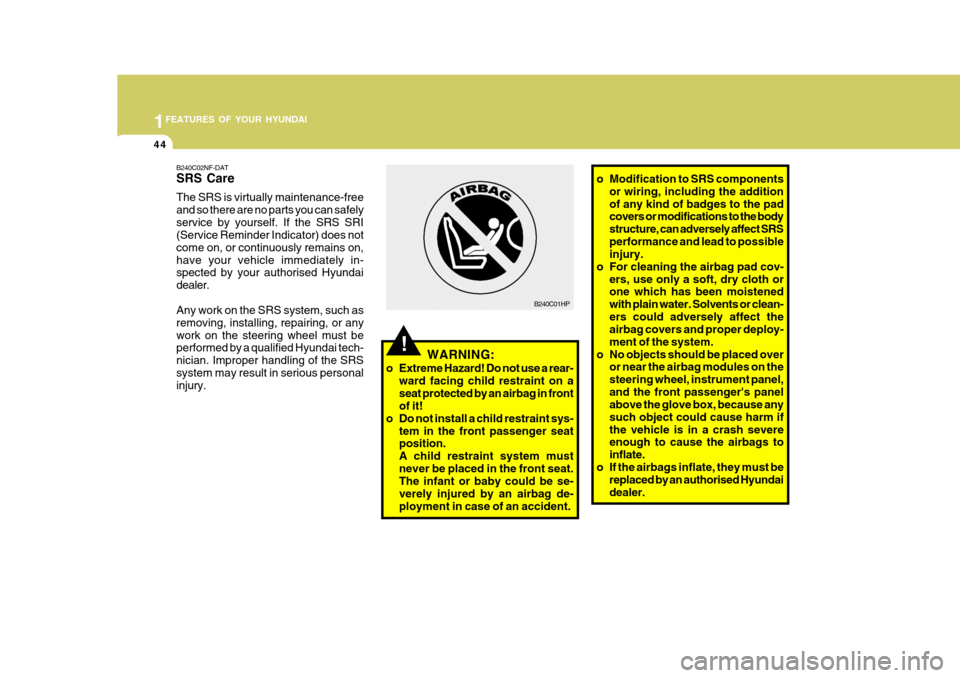
1FEATURES OF YOUR HYUNDAI
44
o Modification to SRS components
or wiring, including the addition of any kind of badges to the pad covers or modifications to the body structure, can adversely affect SRSperformance and lead to possible injury.
o For cleaning the airbag pad cov- ers, use only a soft, dry cloth orone which has been moistened with plain water. Solvents or clean-ers could adversely affect the airbag covers and proper deploy- ment of the system.
o No objects should be placed over or near the airbag modules on thesteering wheel, instrument panel,and the front passenger's panel above the glove box, because any such object could cause harm ifthe vehicle is in a crash severe enough to cause the airbags to inflate.
o If the airbags inflate, they must be replaced by an authorised Hyundaidealer.
!
B240C01HP
WARNING:
o Extreme Hazard! Do not use a rear- ward facing child restraint on a seat protected by an airbag in front of it!
o Do not install a child restraint sys- tem in the front passenger seatposition. A child restraint system mustnever be placed in the front seat. The infant or baby could be se- verely injured by an airbag de-ployment in case of an accident.
B240C02NF-DAT SRS Care The SRS is virtually maintenance-free and so there are no parts you can safelyservice by yourself. If the SRS SRI (Service Reminder Indicator) does not come on, or continuously remains on,have your vehicle immediately in- spected by your authorised Hyundai dealer. Any work on the SRS system, such as removing, installing, repairing, or anywork on the steering wheel must be performed by a qualified Hyundai tech- nician. Improper handling of the SRSsystem may result in serious personal injury.
Page 63 of 232

1FEATURES OF YOUR HYUNDAI
52
B260J01S-DATCharging System Warning Light
The charging system warning light should come on when the ignition isturned on, then go out when the engine is running. If the light stays on while the engine is running, there is amalfunction in the electrical charging system. If the light comes on while you are driving, stop, turn off the engineand check under the bonnet. First, make certain the alternator drive belt is in place. If it is, check the tension of thebelt. If the belt is satisfactory, have the system checked by your Hyundaidealer. B260M01A-AAT
Low Fuel Level Warning Light
The low fuel level warning light comes on when the fuel tank is approaching empty. When it comes on, you should add fuel as soon as possible. Drivingwith the fuel level warning light on or with the fuel level below "E" can cause the engine to misfire and damage thecatalytic converter.
! CAUTION:
If the drive belt (alternator belt) is loose or breaks while the engine isrunning, engine could overheat be- cause this belt also drives the water pump. B260L01A-GAT
Door Ajar Warning Light
The door ajar warning light warns youthat a door is not completely closed.
If the light comes on at any other time, you should slow the vehicle and bring itto a complete stop in a safe location off the roadway. The brake fluid level warn- ing light indicates that the brake fluidlevel fluid level in the brake master cylinder is low and hydraulic brake fluid conforming to DOT 3 or DOT 4 specifi-cations should be added. After adding fluid, if no other trouble is found, the car should be carefully driven to a Hyundaidealer for inspection. If further trouble is experienced, the vehicle should not be driven at all but taken to a dealer by aprofessional towing service or some other safe method. Your Hyundai is equipped with dual-diagonal brakingsystems. This means you still have braking on two wheels even if one of the dual systems should fail. With only oneof the dual systems working, more than normal pedal travel and greater pedal pressure are required to stop the car.Also, the car will not stop in as short a distance with only a portion of the brake system working. If the brakes fail whileyou are driving, shift to a lower gear for additional engine braking and stop the car as soon as it is safe to do so. B260K01MC-DAT
Boot Lid/Tail Gate Open Warning Light
This light remains on unless the boot lid/tail gate is completely closed andlatched.
Page 75 of 232
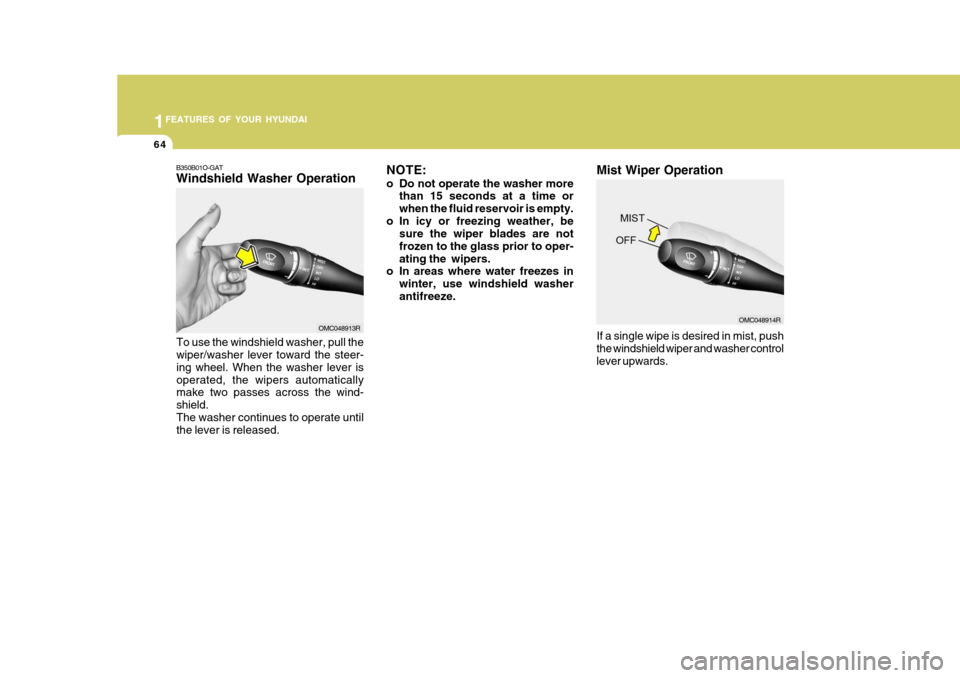
1FEATURES OF YOUR HYUNDAI
64
NOTE:
o Do not operate the washer morethan 15 seconds at a time or when the fluid reservoir is empty.
o In icy or freezing weather, be sure the wiper blades are notfrozen to the glass prior to oper-ating the wipers.
o In areas where water freezes in
winter, use windshield washerantifreeze. Mist Wiper Operation If a single wipe is desired in mist, push the windshield wiper and washer control lever upwards.
OMC048914R
B350B01O-GAT Windshield Washer OperationOMC048913R
To use the windshield washer, pull the wiper/washer lever toward the steer- ing wheel. When the washer lever isoperated, the wipers automatically make two passes across the wind- shield.The washer continues to operate until the lever is released.
Page 98 of 232
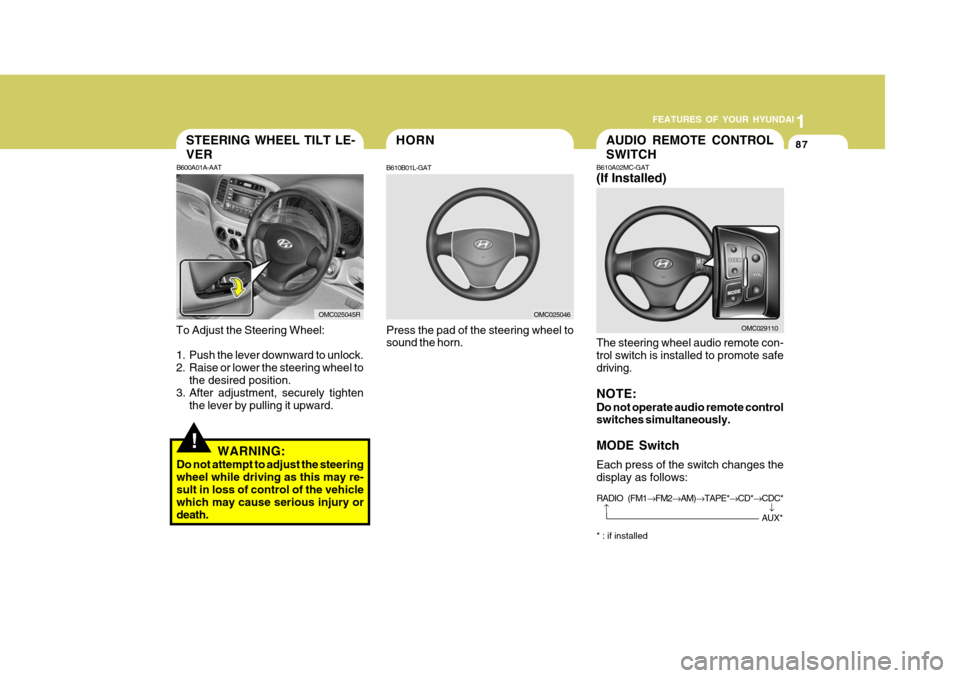
1
FEATURES OF YOUR HYUNDAI
87HORN
B610B01L-GAT
Press the pad of the steering wheel to sound the horn.
OMC025046
!
STEERING WHEEL TILT LE- VER
B600A01A-AAT
To Adjust the Steering Wheel:
1. Push the lever downward to unlock.
2. Raise or lower the steering wheel to the desired position.
3. After adjustment, securely tighten the lever by pulling it upward.
WARNING:
Do not attempt to adjust the steeringwheel while driving as this may re-sult in loss of control of the vehicle which may cause serious injury or death.
OMC025045R
AUDIO REMOTE CONTROL SWITCH
B610A02MC-GAT (If Installed) The steering wheel audio remote con- trol switch is installed to promote safe driving. NOTE: Do not operate audio remote control switches simultaneously. MODE Switch Each press of the switch changes the display as follows: * : if installed OMC029110
�
RADIO (FM1
�FM2 �AM) �TAPE* �CD* �CDC*�
AUX*